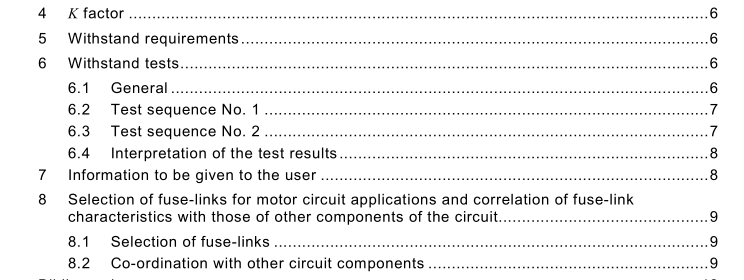EN 60644:2009 – Specification for high-voltage fuse-links for motor circuit application

4 K factor Factor which defines an overload characteristic to which the fuse-link may be repeatedly subjected under specified motor starting conditions, and other specified motor-operating overloads, without deterioration. For the purpose of this specification, the value of K is chosen at 1 0 s.
Unless otherwise stated by the fuse-link manufacturer, it is valid from 5 s to 60 s, for a frequency of starts up to six per hour and for not more than two consecutive starts. For conditions different from those specified above, for example where service conditions involve inching, plugging or more frequent starts, the manufacturer should be consulted. The overload characteristic is obtained by multiplying the current on the pre-arcing characteristic by K (less than unity).
5 Withstand requirements
The performance of a fuse-link for motor circuit applications is in general determined by the following criteria:
– to withstand without deterioration starting pulses in rapid succession due for example to abnormal conditions, such as those occurring during commissioning of the equipment;
– to withstand without deterioration a large number of motor starts in normal service conditions. This standard therefore specifies two sequences of tests representative of these conditions: 1 00 cycles corresponding to abnormal service conditions; 2 000 cycles corresponding to normal service conditions. It is expected that a fuse-link which passes these tests will have a good behaviour during a satisfactory life duration.
6 Withstand tests
6.1 General
The withstand tests are type tests. Both test sequences shall be carried out on the same fuselink. The fuse-link shall be tested under the same test conditions as in 6.5.1 .2 of IEC 60282-1 .
EN 60644:2009 – Specification for high-voltage fuse-links for motor circuit application